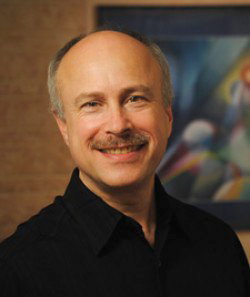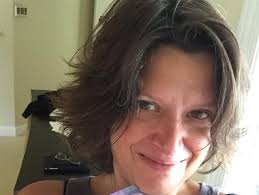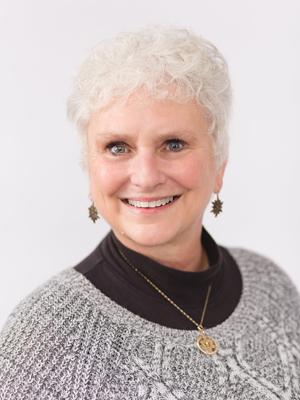The Grace Machine: Healing the Shock of Spiritual Darkness
Printed in the Summer 2019 issue of Quest magazine.
Citation: Leland, Kurt ,"The Grace Machine: Healing the Shock of Spiritual Darkness" Quest 107:3, pg 18-20
By Kurt Leland
 At the beginning of her essay “Spiritual Darkness,” Annie Besant gives perhaps the most graphic depiction of clinical depression in Theosophical literature. She begins by stating: “Few of the perils which beset the path of the serious aspirant are more depressing in their nature, more fatal in their effects, than what is called spiritual darkness.” What follows leaves no doubt that Besant had experienced such a state. She speaks of:
At the beginning of her essay “Spiritual Darkness,” Annie Besant gives perhaps the most graphic depiction of clinical depression in Theosophical literature. She begins by stating: “Few of the perils which beset the path of the serious aspirant are more depressing in their nature, more fatal in their effects, than what is called spiritual darkness.” What follows leaves no doubt that Besant had experienced such a state. She speaks of:
the gloom which descends on the heart and brain, wrapping the whole nature in its somber folds, blotting out all memories of past peace, all hopes of future progress. As a dense fog pervades a great city, stealing into every nook and corner, effacing every familiar landmark, shutting off every vista, blurring into dimness even the brilliant lights, until, to the bewildered wayfarer, nothing seems left save himself and the stifling mephitic vapor that enfolds him, so is it when the fog of spiritual darkness comes down on the aspirant or the disciple. All his landmarks disappear, and the way vanishes in the gloom; his wonted lights are shorn of their luster, and human beings are mere shadows that now and again push up against him out of the night and into the night again disappear . . .The “horror of great darkness” is upon him [cf. Genesis 15:12], paralyzing every energy, crushing every hope. God and man have deserted him—he is alone, alone. (Besant, Essays, 118–19)
Though Besant directs these comments toward spiritual aspirants, the situation she describes is universal. Anyone who has experienced physical, emotional, mental, or spiritual trauma may recognize themselves here, from teenagers suffering over the first breakup of a love relationship to adults helplessly watching as their community is destroyed by wildfire. Tragedies such as rape, violence, and sexual abuse and natural catastrophes such as hurricanes, earthquakes, and tsunamis may leave in their wake from one to tens of thousands of people in this spiritual darkness.
Several years ago, a dear friend arrived on my doorstep in this state: white with fear, in a cold sweat, paralyzed by anxiety. I did what I could to calm him down, but a few days later I learned he had threatened suicide and been hospitalized. Some preparations had been made to get him into a residential treatment program that seemed like a good fit, though it was far from home. I sat by his side during the long trip there and helped him settle in. After his program was over, I returned to pick him up. He stayed with me for some days until I found him a long-term home. I put him in touch with professionals who helped him assemble a treatment team. There were ups and downs, period of progress and setback, but I’m happy to say that with the help of his team and the loving support of his family, he made a complete recovery.
The great gift of this period was what I learned from weekly in-person chats with my friend as I watched his healing process. Here is what I extrapolated from those meetings, pondered on in the light of Theosophy.
Perhaps the most helpful guiding principle of our chats was one for which Besant was famous: the idea that we have a physical body and several subtle bodies, including the emotional (sometimes called astral), mental, and causal (so called because it holds the causes from past lives that affect our present lifetime). In this article, I’ll use the term soul body instead of causal body, since the latter is often identified with the human soul. There are other bodies beyond these, but they do not concern us here.
Earlier I mentioned trauma in connection with this spiritual darkness. Trauma could be defined as an injury to the physical, emotional, mental, or causal body, or any combination thereof. The injury takes the form of more information coming into the body than it can assimilate in the moment, resulting in a loss of equilibrium and a shutdown of processing such information. The loss of equilibrium may be experienced along a continuum from simple overwhelm to uttermost terror—various shades of fearing that the integrity of the body is compromised or its existence threatened. The body is effectively paralyzed, producing a state of shock. This shock is what Besant described as spiritual darkness. It lasts as long as required for the affected body to recover its processing ability and restore its equilibrium, to feel reassured of its integrity and reestablished in a sense of safety. Though an outside observer might describe this shock as physical, emotional, or psychological, according to the body affected, the experiencer may not be able to make such distinctions. The feeling of being utterly without hope and help, cut off from “God and man,” results in spiritual darkness, no matter which body is involved.
Each body has its own vulnerability to the shock and trauma of too much information. For example, the physical body is overwhelmed when the immune system can’t keep up with the replication of bacteria, viruses, or malignant cells; or by pain or blood loss in cases of injury, accident, or abuse. Though healing may eventually occur, the nervous system seems to remember and store such traumas for years—and may not recover full functionality without some form of trauma-release work. (There are a number of healing modalities that proceed along such lines, such as the technique of somatic experiencing pioneered by Peter Levine.)
Emotional trauma can take the form of abuse by a victimizer who arbitrarily grants and withholds love or instills fear as a means of control. It can also result from the loss of any loved one, especially when that loss is sudden and tragic.
Mental trauma can develop from abuse, in particular constant judgment or criticism. It can also occur when the magnitude of a tragedy simply cannot be comprehended—and this may be true not only for eyewitnesses but also for people exposed to gruesome reportage in news media.
Trauma to the causal body can occur through loss of an idol or role model, a mentor or spiritual teacher. The causal body may also be traumatized by brainwashing and cult indoctrination.
In every case, one or more of the bodies is affected by information that overwhelms and paralyzes it. Often awareness is withdrawn from the affected body. Physical sensations are deadened, ignored, or not even registered. The same occurs with feelings and emotions in the emotional body and constructive thoughts in the mental body. The self hunkers down in the mental body, cut off not only from sensations, emotions, and thoughts, but also from understanding, guidance, and illumination from the higher Self. Anxiety runs riot because of fear of further trauma and an urgent desire for release from pain.
To help someone experiencing the shock of spiritual darkness, one thing we can do is support a gradual process of reoccupying the bodies. First, to the extent we’re able, we create safety by providing body-to-body connection (healing touch, hugs), heart-to-heart connection (sympathetic listening, caring concern), mind-to-mind connection (reinforcing shared beliefs and values that mitigate fear and support a positive outlook on life).
Soul-to-soul connection may be more challenging to establish. Often people who have experienced trauma or tragedy feel betrayed by the soul, God, the universe—even to the point of losing faith that such things exist. In such cases, the best medicine is simple witnessing, deep compassionate listening, letting those who suffer know they’re loved no matter what they’re thinking or feeling. The statement “Know that you are loved” can work wonders because it invites people to notice where, when, and by whom they’re loved as they’re ready to become aware of that love again and perhaps feel grateful for it. On the other hand, saying “I love you” to someone experiencing spiritual darkness could be traumatizing because they might not feel worthy of that love.
If I listen deeply enough to people who are suffering, I often become aware of what I call their inner healer. This is the voice of their soul expressing what it needs. In those who suffer, this inner voice is often drowned out by other voices vying for attention—critical, angry, despairing, or anxious. I try to capture, repeat, highlight, and reinforce moments when the inner healer speaks, expressing a need or insight that could alleviate suffering and carry forward the healing process. But to hear the voice of another’s inner healer, I have to be compassionate, patient, unattached to outcomes.
Over several years of weekly chats with my friend, certain questions emerged in my mind. I would periodically introduce them into our conversation as things to consider. In the early stages, they didn’t register or were dismissed. But over time they became conversation topics, and later they were internalized and brought up by him without prompting—often with answers he had been thinking about.
There were six such questions. I’ve experimented with them in other contexts, including workshops, as focal points for meditation. In one workshop, I briefly explained these questions, then asked the first and struck a Tibetan singing bowl. People could hold each question in mind, perhaps repeating it inwardly while noticing their reactions, which might include doubtfulness or acceptance. When the sound became inaudible, I went on to the next.
I believe these questions can soften the mental body so support, guidance, and illumination from the soul body become more available. These questions could be used for establishing and sustaining soul-to-soul connection with someone who’s experiencing spiritual darkness—as long as we don’t press for answers.
- Am I willing to accept the conditions of my growth as the beginning point for change? This brings us out of denial of the past and anxiety over the future into the present moment by overcoming the mind’s tendency to reject what it dislikes, including trauma and its effects. We can’t heal from trauma unless we’re willing to learn what it has to teach us. Acceptance that trauma has occurred is the first step to growth.
- Am I willing to be responsible for the consequences of my actions and learn from my past? The mental body tends to blame us or others for undesirable consequences we’ve experienced, but the soul body knows why anything has happened to us. A willingness to be responsible for our actions, no matter how much pain they may have caused, can open the way for soul-level understanding to come through. We may then discover what we’ve learned from such actions and why their consequences were necessary.
- Can I turn my fears into intentions to grow? Paralysis in the mental body caused by anxiety can often be alleviated by identifying the unknowns that cause fear and expressing a willingness to explore them until they become known. Thus paralysis about applying for a job could be overcome by expressing an intention to learn how to create an effective résumé or to request, fill out, and submit an attractive application.
- When confused, can I open an inquiry into the forces in play? At the soul-body level, everything we experience is a result of the interaction of various forces. Not knowing what they are overwhelms and confuses us. By opening an inquiry into these forces—the causes or influences affecting us in the moment—we can make the mind more receptive to illumination from the soul body. Such forces may include our own thoughts, feelings, and actions, as well as those of others, such as family or coworkers. They can also involve physical conditions such as the weather and the aura or ambience of our emotional, mental, and spiritual environments, where we live, work, play, or seek intellectual or spiritual nourishment. (See C.W. Leadbeater’s Hidden Side of Things for information about the influence of subtle environmental forces.) Breaking trauma down into such forces can help process information that may have overwhelmed or paralyzed any of our bodies.
- Am I willing to be an agent of turning stuckness into flow? People who have experienced trauma often feel urgency to free themselves from paralysis and pain. They may search for quick fixes and look to us for such solutions. But trauma may be more of a process than a problem—not something to fix but something to help along. A more reasonable approach is seeing it as a temporary experience of stuckness and suggesting a single step that might move that stuckness into flow. Taking action on that step breaks down paralysis and may help the individual understand and integrate the trauma. The feeling of flow indicates that we’re more in touch with the forces in play and more available to guidance by the soul body.
- Can I be grateful for the support and guidance of higher powers? Whether such powers include the soul, a guiding angel, God, or the universe, our gratitude for its support and guidance helps us perceive and accept them.
These observations above are intended to be suggestive rather than definitive. However, I should explain the background of the sixth question more thoroughly. For me, the universe is a great Grace Machine. At the center is our divine Source, shining like a spiritual sun, radiating joy. We’re all on a journey back to oneness with it. As we experience trauma in any of our bodies, we turn away from that Source—how could it have permitted us to experience that trauma and the suffering it caused? The more we turn away, the more tightly we become wound up in our bodies to protect us from further trauma. We close out the light and joy of the Source, and the result is various grades of spiritual darkness.
Yet in every moment the Source attempts to turn us back toward it. Working through the law of karma, it sends us experiences that unwind our trauma, wear down our faults, and strengthen our virtues. Eventually, we all achieve the goal of returning to oneness with it—and that is grace. There’s plenty of room for error and there are plenty of lifetimes to correct our mistakes.
At every moment we’re surrounded by beings, people, objects, and situations that point the way back to the Source, if we’re willing to see them and act appropriately. Gratitude for this support and guidance makes it easier to do so. By acting appropriately, I mean turning stuckness into flow.
The sign that we’ve acted appropriately is an increase in joy, because we’ve turned back toward or advanced a bit closer to the Source. Besant has something to say about this joy. It seems fitting to close with her words, since they represent the glorious opposite of the spiritual darkness we began with:
They err who believe that sorrow is the end of things; they err who believe that pain and sadness are really the atmosphere in which the Spirit lives. The Spirit is bliss, it is not sorrow; the Spirit is joy, it is not struggle. The essence and heart of all things is love, is joy, is peace; and the path of pain is the path and not the goal. . . . For out of that ocean of Blessedness whence the universe has sprung, spring love and joy and peace unceasing. (Besant, Pain, 27–28)
And that is the Grace Machine, always working to bring us closer to such love, joy, and peace—from whatever trauma or tragedy we may have experienced in this or any other life. Thus for me, tragedy seen in the light of Theosophy is a constant prayer to serve the great Grace Machine by being an agent of turning stuckness into flow.
Sources
Besant, Annie. Essays and Addresses, Vol. 2: The Spiritual Life. London: Theosophical Publishing Society, 1912.
———. Man and His Bodies. Adyar: Theosophical Publishing House, 2008.
———.Pain: Its Meaning and Use. Adyar: Theosophical Publishing House, 2003.
Leadbeater, C.W. The Hidden Side of Things. Adyar: Theosophical Publishing House, 1912.
Composer and author Kurt Leland lectures regularly for the TSA. His books include a compilation of Annie Besant’s articles: Invisible Worlds: Essays on Psychic and Spiritual Development (Quest Books, 2013) and Rainbow Body: A History of the Western Chakra System from Blavatsky to Brennan (Ibis, 2016). His consulting practice, Spiritual Orienteering, is based in Boston. He can be reached at www.kurtleland.com. Videos of his lectures can be found on the TS YouTube channel.


 As I awakened, I realized that Simon, my beloved cat companion, was not licking my face, nor had he lain on my pillow cocooned around my head as he had done each night for the past thirteen years. It was his ritual, which had become mine. More than I knew.
As I awakened, I realized that Simon, my beloved cat companion, was not licking my face, nor had he lain on my pillow cocooned around my head as he had done each night for the past thirteen years. It was his ritual, which had become mine. More than I knew. The focus of this issue of Quest is ahimsa. This word, familiar to many who tread the spiritual path, derives from the Sanskrit himsa, meaning to strike, injure, or harm. Ahimsa has the opposite meaning: to cause no harm or do no injury. Ahimsa is to have respect for all life and to avoid violence toward all others.
The focus of this issue of Quest is ahimsa. This word, familiar to many who tread the spiritual path, derives from the Sanskrit himsa, meaning to strike, injure, or harm. Ahimsa has the opposite meaning: to cause no harm or do no injury. Ahimsa is to have respect for all life and to avoid violence toward all others.